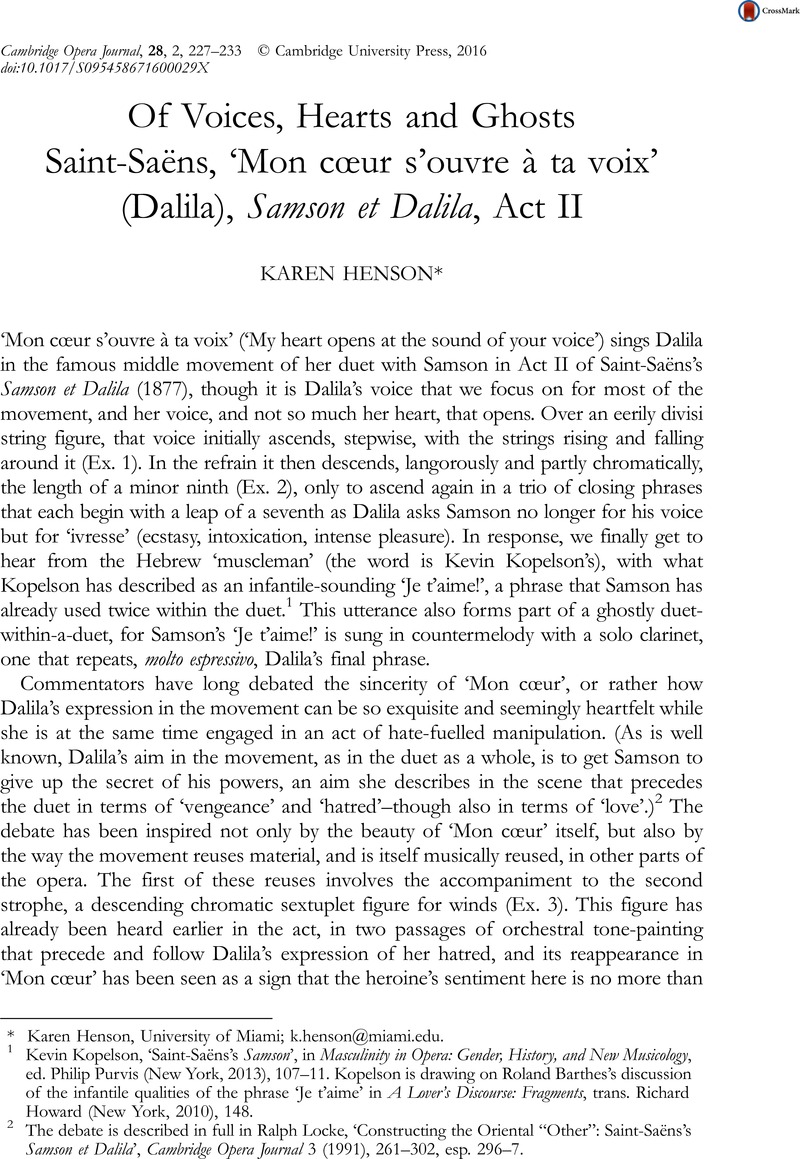No CrossRef data available.
Article contents
Of Voices, Hearts and Ghosts Saint-Saëns, ‘Mon cœur s’ouvre à ta voix’ (Dalila), Samson et Dalila, Act II
Published online by Cambridge University Press: 28 September 2016
Abstract

- Type
- Research Article
- Information
- Cambridge Opera Journal , Volume 28 , Special Issue 2: Special Issue: Remaking the Aria , July 2016 , pp. 227 - 233
- Copyright
- © Cambridge University Press 2016
Footnotes
Karen Henson, University of Miami; [email protected].
References
1 Kopelson, Kevin, ‘Saint-Saëns’s Samson ’, in Masculinity in Opera: Gender, History, and New Musicology, ed. Philip Purvis (New York, 2013), 107–111 Google Scholar. Kopelson is drawing on Roland Barthes’s discussion of the infantile qualities of the phrase ‘Je t’aime’ in A Lover’s Discourse: Fragments, trans. Richard Howard (New York, 2010), 148.
2 The debate is described in full in Locke, Ralph, ‘Constructing the Oriental “Other”: Saint-Saëns’s Samson et Dalila ’, Cambridge Opera Journal 3 (1991), 261–302 CrossRefGoogle Scholar, esp. 296–7.
3 See, for example, Delage, Roger, ‘Saint-Saëns: “Samson et Dalila”’, L’Avant-scène Opéra, 15 (1978), 47–49 Google Scholar, 72–5 and 90, and Conrad, Peter, A Song of Love and Death: The Meaning of Opera (New York, 1987), 20 Google Scholar.
4 Locke, ‘Constructing the Oriental “Other”’, 285 and 297.
5 When it comes to desire, one should also mention the half-diminished harmonies that Saint-Saëns, who was at this point an enthusiastic Wagnerian, introduces into the accompaniment just before each refrain.
6 According to the Orpheus myth, the ancient Greek poet-musician’s singing was so beautiful that it caused the natural world and even the rocks around him to be moved. Dalila’s descending ninth is of course also chromatic and therefore potentially has a supernatural quality.
7 For more on Saint-Saëns’s drag performances, see Morris, Mitchell, ‘Saint-Saëns in (Semi-)Private’, in Camille Saint-Saëns and His World, ed. Jann Pasler (Princeton, 2012), 2–11 Google Scholar.
8 See Zviguilsky, Alexandre, ‘L’Exécution du second acte de “Samson et Dalila” à Croissy’, Cahiers Ivan Tourguéniev, Pauline Viardot, Maria Malibran 9 (1985), 123–125 Google Scholar.
9 Saint-Saëns, Camille, ‘Pauline Viardot’, in École buissonnière: Notes et souvenirs (Paris, 1913), 217 Google Scholar (‘[une voix] d’une puissance énorme et d’une étendue prodigieuse ... [et de] la saveur de l’orange amère’). Pasta was of course an important bel canto predecessor; see Rutherford, Susan, ‘“La cantante delle passioni”: Giuditta Pasta and the Idea of Operatic Performance’, Cambridge Opera Journal 19 (2007), 111 CrossRefGoogle Scholar.
10 Pasler, Jann, ‘Contingencies of Meaning in Transcriptions and Excerpts: Popularizing Samson et Dalila ’, in Approaches to Meaning in Music, ed. Byron Almén and Edward Pearsall (Bloomington and Indianapolis, 2006), 174 Google Scholar. For more on the genesis of the opera, which began life as an oratorio (parts of which date back to the late 1850s), see Ratner, Sabina Teller, ‘La Genèse et la fortune de “Samson et Dalila”’, Cahiers Ivan Tourguéniev, Pauline Viardot, Maria Malibran 9 (1985), 109–121 Google Scholar.
11 Kopelson, ‘Saint-Saëns’s Samson’, 111 (‘Viardot, unfortunately, never got to perform [the role] except for one time at a party. By the time [the opera was] first staged, the poor woman ... was simply too old to perform’). Also Collet, Henri, ‘Samson et Dalila’ de Camille Saint-Saëns: Étude historique et critique, analyse musicale (Paris, 1922), 33 Google Scholar (‘J’avais destinée le rôle de Dalila à Mme Viardot ... mais ... quand je pus faire jouer l’ouvrage ... il était trop tard’; Collet is quoting from a personal letter from Saint-Saëns). Viardot’s lover, the novelist Ivan Turgenev, would have disagreed with such comments: he went to some trouble to see Viardot in the private performance and described her as Dalila as ‘véritablement très belle’. Quoted in Zviguilsky, ‘L’Exécution du second acte’, 124.


